What are common knee injuries
The knee is the body’s largest joint and made up of four bones; the shin bone (tibia), the thigh bone (femur), a smaller bone on the outside of the leg (fibula) that attaches to the shin bone and helps support body weight, and the knee cap (patella). The knee joint is called a hinge joint, as it can bend, straighten and twist.

Each of the ends of the bones in the knee are covered in cartilage to protect the bones and let the joint move smoothly. Between the bones in the knee, there are 2 wedge-shaped pieces of cartilage, called meniscii. These are the shock absorbers and help cushion the joint from impact.
The knee joint is held together by ligaments which make the joint stable. There are four main ligaments in the knee. There are the collateral ligaments which run down the sides of the knee, which help to limit sideways movement of the joint and support against unusual movement. Then there are the cruciate ligaments, which are inside the knee and cross each other, to control back and forth movement in the joint.
Another factor in knee stability is muscles which also provide power and are the reason the joints can move. The knee is surrounded by strong muscles. The quadriceps are the front thigh muscles and they work to straighten the knee. If they are weak then this can lead to instability of the knee and kneecap. The hamstrings are the muscles on the back of the leg and their job is to bend the knee.
Which are inside the knee and cross each other, to control back-and-forth movement in the joint.
Another factor in knee stability is muscles which also provide power and are the reason the joints can move. The knee is surrounded by strong muscles. The quadriceps are the front thigh muscles and they work to straighten the knee. If they are weak then this can lead to instability of the knee and kneecap. The hamstrings are the muscles on the back of the leg and their job is to bend the knee.
Common knee injuries/conditions:
Knee ligament injuries – Normally from an accident, whether a slip, trip or fall. As mentioned above there are several different ligaments that support the knee. If you think you may have injured one, it is important that you see a Physiotherapist/Sports Therapist who can examine your knee to diagnose which ligament is damaged and how badly.
 Osteoarthritis - wear and tear of the cartilage in the knee is called Osteoarthritis and is a common cause of pain. It may be aggravated by biomechanics, previous injury, overuse or the simple effect of years of living. Osteoarthritis symptoms can be relieved with orthotics, exercise and pain-relieving treatments.
Osteoarthritis - wear and tear of the cartilage in the knee is called Osteoarthritis and is a common cause of pain. It may be aggravated by biomechanics, previous injury, overuse or the simple effect of years of living. Osteoarthritis symptoms can be relieved with orthotics, exercise and pain-relieving treatments.
Cartilage injuries – often caused by sudden twisting, the cartilage between the knee can get damaged. If this is the case the knee needs strengthening and there may be a chance that surgery is required. It is crucial that you have a proper assessment to determine the best course of action.
The Impact of Leverage
When we can’t undo a tight nut, we reach for a longer spanner to give us more leverage. It’s a concept we all understand.
This same leverage principle applies to our knees as well because for most of the time the centre of our weight is not directly over our knees. Try looking sideways in a mirror and bend your knees and you will see that your knees are in front of the trunk of your body. Hence your body weight is applying leverage on your knees. As you bend your knees further, your knees get further in front and the leverage increases, just like using a longer spanner.

The implications of this leverage are that in normal walking your knees have to support 4 times your weight. If you crouch down it can go as 9 times your weight. No wonder then that if we carry excess weight, our knees will take the brunt of that, which means that knee problems are likely to be more likely with excess weight.
The good news is that most of us have the capability to do something about our weight. A simple change in diet and a bit more exercise is all it usually takes. And, of course, the motivation to do this.
Most common knee injuries in sports
The knees are frequently injured due to the stress of frequent starts, stops, twists and turns applied to the joint during exercise.
- The most common injury in the knee is knee ligament injuries. This normally occurs from an accident, whether a slip, trip or fall. The ligaments’ main role is to stabilise the knee so the knee might experience a sudden twisting motion, a rapid change in direction, or an incorrect landing from a jump. Sometimes you can hear a pop, or a snap followed by swelling and a loss of range of motion. It is important to see a physiotherapist/ sports therapist who can examine your knee to diagnose which ligament is damaged and how badly, so we can treat it sooner rather than later.
- Another common injury is to the meniscus (shock absorbers) of the knee. This can happen from general aging where the meniscus has become weak and tears after an awkward turn during normal day to day activities. Or it can happen during sports where the knee twists and pivots. You will normally feel pain, stiffness, locking and a decreased range of motion.
- Meniscus damage can take time to heal and can get worse over time if it isn’t treated properly by a physiotherapist/ sports therapist. It is crucial to have a proper assessment to determine the best course of action.
Overuse injuries are also common, including ‘runners’ knee’ or osteoarthritis.
- Runner’s knee is common in runners and cyclists. You often have dull pain around the front of the knee and can feel like a rubbing, grinding, or clicking sound in the knee cap. Your physiotherapist/sports therapist can help treat runners’ knee through a combination of massage and acupuncture. This will help relieve some of the pain and break that vicious cycle.
Looking after yourself and keeping healthy will most likely keep knees healthy too. Getting help sooner rather than later will also help massively with recovery time and getting you back to your day-to-day pain free activities.
If you are suffering with knee problems, you really need to see a physiotherapist/sports therapist sooner rather than later to correctly diagnose and then provide the best treatment possible.
Call 01889 881488 Now
Erica, Jean and Charlotte will be happy to help
